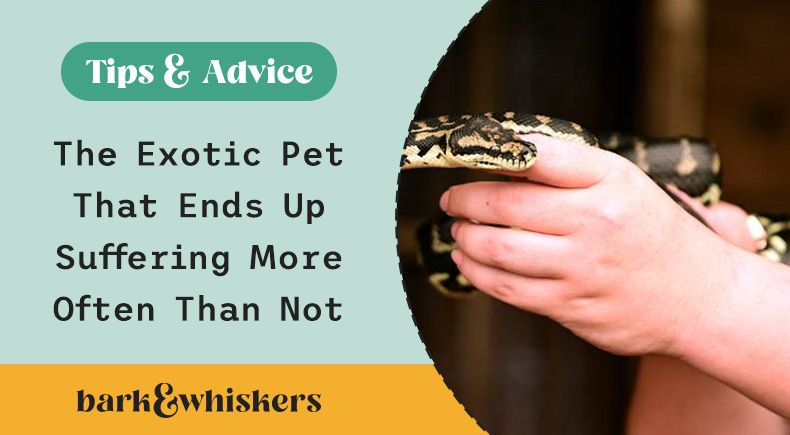The Exotic Pet That Ends Up Suffering More Often Than Not
A survey of 744 owners shows more than half don't provide adequate housing, and that can lead to both physical and behavioral issues. Others simply don't give their exotic pet the special care they need. And that's too bad, because when they receive the right care, they make wonderful pets.

STORY AT-A-GLANCE
- A survey of 744 snake owners worldwide revealed that many pet snakes are suffering because their owners aren’t caring for them properly
- 54.7% of snake owners kept their snakes in enclosures shorter in length or height than their body, which means they were unable to fully stretch out
- 24% did not check the temperature in their snake’s enclosure daily as recommended; 48.1% of the snake owners did not measure the humidity in their snake’s enclosure
- Snakes kept in enclosures that were smaller than one snake length were more likely to experience physical symptoms than snakes kept in larger enclosures
- Many of the snakes exhibited behavioral issues associated with stress in captivity
- If you’re willing to put in the effort to care for these creatures correctly, captive-bred snakes can thrive in captivity and make interesting pets
Only 2% of U.S. pet owners have a reptile, such as a snake or lizard, as their pet. But among snake lovers, there’s nothing better than “cuddling” up to these beautiful, scaly creatures. Being the exotic pets that they are, they require specialized care to keep them healthy and are definitely not “starter” pets that can simply be left in their enclosures unattended.
A survey of 744 snake owners worldwide has revealed, however, that many pet snakes are suffering because their owners aren’t caring for them properly — either due to unawareness or negligence.
Snakes Often Kept in Inadequate Habitats
The study, which was funded by Universities Federation for Animal Welfare (UFAW) and led by Bristol Veterinary School, investigated snake care including enclosure size, temperature and humidity via a survey of snake owners. Most of the responses came from the U.K. and referred to the three most common families of snakes — pythonoids (pythons), boids (boas) and colubrids.
The researchers were looking for associations between housing and husbandry practices and clinical signs of ill health, including behavioral issues. A number of concerning issues were found, including:
- 54.7% kept snakes in enclosures shorter in length or height than their body, which means they were unable to fully stretch out
- 10.2% of U.K. snakes were kept in enclosures that did not comply with the recommended guidelines of minimum enclosure length <0.66 of snake length
Regarding temperature, 93.1% of snake owners said they measured the temperature in their pet’s enclosure. However, 24% did not check it daily as recommended. Further, 47.2% of the most common pet snakes — royal pythons, corn snakes and boa constrictors — were kept in improper temperatures.
Humidity, another essential element to properly care for a snake, was also often overlooked; 48.1% of the snake owners surveyed said they did not measure the humidity in their snake’s enclosure.
Snakes Are Suffering Due to Improper Care
Many of the snakes were also experiencing health issues. Those kept in enclosures that were smaller than one snake length were more likely to experience physical symptoms than snakes kept in larger enclosures. Specifically:
- 28.2% of snakes experienced abnormal skin shedding
- 11.2% had parasites
- 7.4% had rostral cuts and scrapes
- 5.6% had respiratory problems
Snakes that had more of the physical symptoms listed above also displayed more negative behaviors, including those associated with stress in captivity. These include:
- Interacting with transparent boundaries (52.8%)
- Wincing or withdrawing its head when touched gently (52.4%)
- Putting its head under the enclosure’s substrate (52.1%)
- Unusually high level of activity (51.1%)
- Attempting to escape (45.9%)
According to Nicola Rooney, Ph.D., one of the study’s authors:
"Our study has highlighted various concerns for snake welfare. The first of these relates to enclosure size, with snakes commonly being kept in vivaria [an aquarium or tank] preventing straight-line postures and movement. Snakes that were unable to stretch out fully had more clinical signs than those that were able to stretch out fully.
Whilst we did not find a significant association between temperature or humidity and measures of health and welfare in this study, it is a concern that many snakes were housed in conditions considered sub-optimal for their species. We know that appropriate temperature and humidity is vital for maintaining the health of snakes and it would therefore be prudent to investigate these associations further, using methods other than owner reporting."
Snake Care Basics Every Owner Should Know
Snakes make wonderful pets, but they’re not for everyone. Before adding a snake to your home, get educated about their unique care requirements, starting with which species make the best pets.
I do not recommend buying a wild-caught snake that has been taken from its natural habitat. Not only do wild snakes often carry parasites, but they’re likely to decline in health in captivity. Captive-bred snakes are best as pets; they’re likely to be healthier and more comfortable living in your home habitat instead of the outdoors. They also tend to be easier to handle and more likely to eat frozen, thawed prey in lieu of live prey.
Keep in mind, however, that even among captive snakes there will be differences in personality, with some being calmer and others more aggressive. Good snakes for beginners include corn snakes, kingsnakes, gopher snakes and ball pythons.
Snakes are referred to as "cold blooded" because they are exothermic animals; their body temperature is the same as the air temperature in their enclosure or other surroundings. The best temperature for your snake depends on its species, and all snakes need a warm side to their enclosure, and a cooler side. This allows your snake to thermoregulate, a behavior that’s crucial to good health.
It’s important to research the optimal temperature range for your species of snake and monitor hot and cold sides of the tank with a thermometer.
Snakes do best with a radiant heat source that rests on a secure screen top that simulates the sun (a heat light with appropriate wattage to create the ideal hot spot). Snakes also need a day and night cycle, so you’ll need to provide light during the day and darkness at night. Black and red heat lights can also be used to provide heat at night.
An under-tank heating system that assists in digestion works well under the hide box. Do not use a “hot rock,” which can cause burns. Humidity also matters. Too little humidity will make it difficult for your snake to shed its skin, while too much humidity can lead to skin blistering, infections and breathing difficulties. A humidity gauge can be used to make sure it’s kept just right.
Inside your snake’s enclosure should be hiding spots, natural surfaces such as rocks to assist with shedding and a sturdy water bowl large enough for the whole snake to soak in. The enclosure itself must also be sufficiently large for your snake to stretch out in; a 30-gallon long aquarium is typically sufficient for the beginner snake species mentioned, though the more space you can offer, the better. Minimum cage length should be the length of their body, with bigger enclosures providing more environmental enrichment.
Remember that snakes require regular veterinary care just like cats and dogs, so find an exotic vet in your area who specializes in caring for snakes. If you’re willing to put in the effort to care for these creatures correctly, they can thrive in captivity and make interesting pets. Many snakes are sitting in reptile rescue organizations right now, just waiting for the right person to take them home.
Sources & References
Today's Pet Video:
Adorable Kittens Learning To Be Adorable Cats
Fifi, Lili and Titi have a lot of fun exploring their small world, but also learning and testing out their own unique capabilities while climbing, wrestling and playing well with others.










